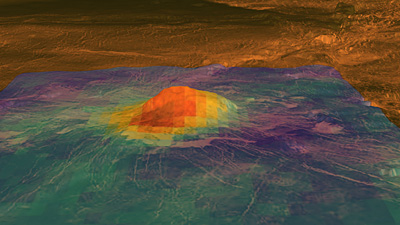She is alive!
 The morning (it’s Evening) star and the closest relative of the Earth, the planet Venus, reveals clear signs of life. From a geological point of view. Convincing evidence of the volcanic activity of the planet was provided by Venus Express, a vehicle of the European Space Agency (ESA), which was registered on the planet’s orbit in April 2006.
The morning (it’s Evening) star and the closest relative of the Earth, the planet Venus, reveals clear signs of life. From a geological point of view. Convincing evidence of the volcanic activity of the planet was provided by Venus Express, a vehicle of the European Space Agency (ESA), which was registered on the planet’s orbit in April 2006.For a long time, the geological history of Venus was an enigma, which deprived sleep of experienced planetologists, and the iron messengers, who bravely sparkled with rectangular ears in the sun, indicated only the existence of this phenomenon by flirty half-hints. However, not all of them were so useless - the results of current observations were combined with the topological data obtained by the Nace Magellan in 1990-94.
What is the batch?
')
The fact is that there are not enough craters on the surface of Venus. Not enough when compared with other similar bodies of the solar system. Something smoothes the surface of the planet, as if the chupa chups licked itself, eliminating the tentative irregularities of its short-lived body. Now, when it is known that the lava flows that are squeezed to the surface are responsible for this, the question arises, what is the intensity of the phenomenon. Observations point to a slow succession of small eruptions against the opinion of volcanic catalysts that are rapidly changing the face of the planet.
How do they know that?
VIRTIS, an optical and infrared spectrometer installed on board the Venus Express, measured the level of infrared radiation emitted from different parts of the planet's surface, and revealed that some regions are noticeably “brighter” than others. The difference in temperature (= intensity of infrared radiation) is explained by the difference in the chemical composition of the surface. Here on Earth, streams of erupting lava interact with oxygen and other elements in the atmosphere that change the chemical composition of these streams. On Venus, the process seems to be similar, but it is notable for its unrestrained fury due to the hotter and denser atmosphere, consisting mainly of carbon dioxide.
It is estimated that the eruptions occurred on Venus about 2.5 million years ago (a negligible period on a geological scale!), If not earlier.
As stated above, the planet’s volcanic orgasms are not so frequent - the process goes gradually, sensibly, with the arrangement, as before. But what if planetologists are wrong? There are some rather intriguing assumptions that Venus could still cover itself with thick layers of volcanic mayonnaise in a very short time, but they require that the internal structure of Venus is very different from the earth. If the volcanic activity of the planet is more moderate, as most believe, this means that the interior of Venus is in accordance with the earth.
So what?
Of course, after methane snow on Titan or a hexagon vortex at the Saturn pole, information about volcanic activity on Venus may not seem so interesting, and the changes taking place on its surface are not so effective, but this is another proof of close relationship of the planets, and the search for extraterrestrial life is not yielding results yet, then at the planetary level (and every planet has a soul!), we can observe signs of similarity to something different, native.
Where the woods come from
The basis for the written taken articles from the portals of ESA and NASA
Source: https://habr.com/ru/post/92228/
All Articles